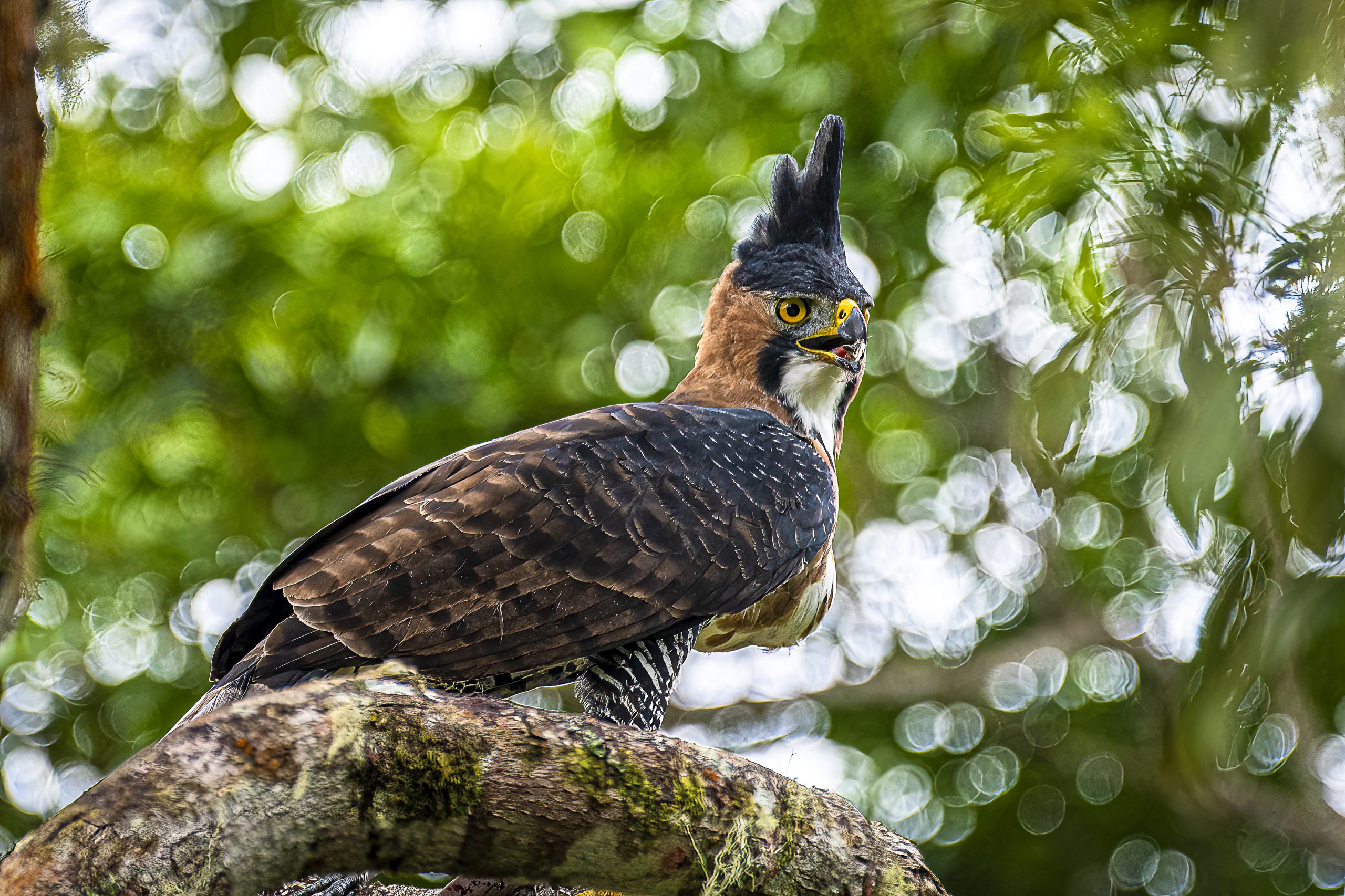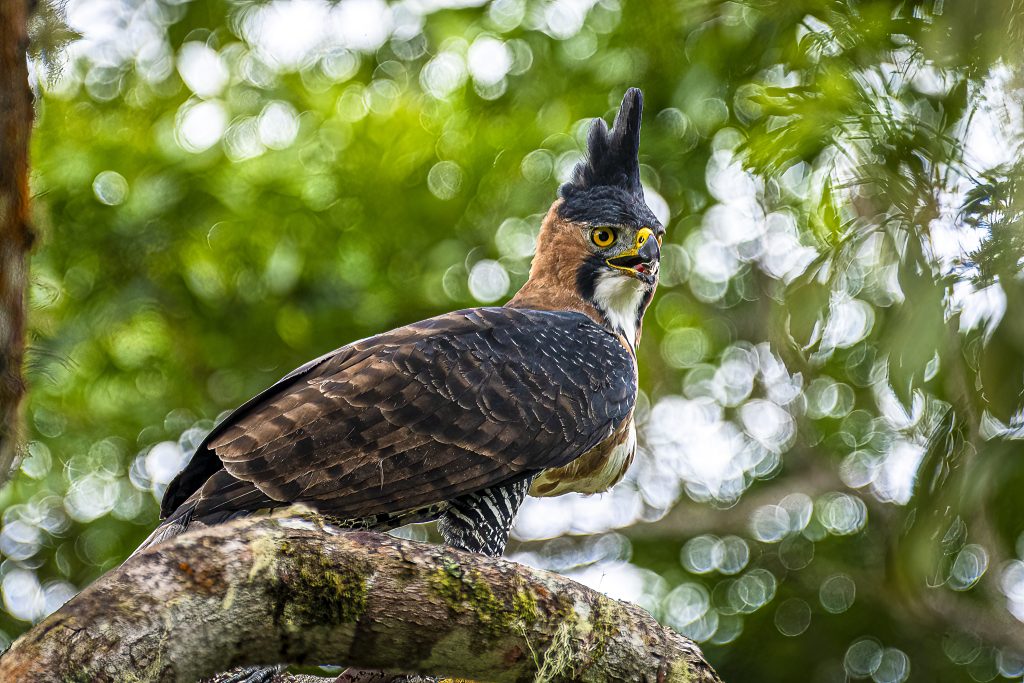The Ornate Hawk-Eagle (Spizaetus ornatus) in Panama: A Jewel of the Neotropical Skies
Introduction to the Ornate Hawk-Eagle
The Ornate Hawk-Eagle (Spizaetus ornatus) is one of the most striking and elusive raptors found in the dense rainforests of Panama. Known for its bold plumage, fierce predatory behavior, and mysterious aura, this eagle stands as a symbol of the wild beauty of Central America’s forests. While its population is declining across much of its range, Panama remains a crucial stronghold for the species, making conservation efforts in this region especially important.
Taxonomy and Classification
Belonging to the Accipitridae family, the Ornate Hawk-Eagle is part of the genus Spizaetus, which includes several forest-dwelling eagle species. Its scientific name, Spizaetus ornatus, reflects the bird’s ornate feather patterns and regal posture.
Physical Description
This raptor is immediately identifiable by its exquisite feathering:
-
Crested head with a long, black, and white-tipped crest
-
Striking orange to rufous chest with bold black streaks
-
Black wings and upperparts contrasted by a white belly and underwings
-
Bright yellow eyes set in a strong, curved beak
Juvenile birds are paler with more white on the head and underparts, gradually attaining adult plumage within 2-3 years.
Distribution in Panama
Panama, with its diverse elevations and intact forest corridors, offers one of the last viable habitats for the Ornate Hawk-Eagle in Central America. The species can be found throughout:
-
Darién National Park
-
Soberanía National Park
-
La Amistad International Park
-
Santa Fé National Park
These areas offer a mosaic of primary and secondary forest, perfect for the eagle’s nesting and hunting needs.
Habitat Preferences
The Ornate Hawk-Eagle thrives in humid tropical forests, particularly undisturbed lowland and foothill forests. It favors dense canopy cover, where it can perch and scout for prey undetected. Altitudes typically range from sea level up to 1,500 meters, although sightings have been recorded up to 2,000 meters in cloud forests.
Diet and Hunting Techniques
This eagle is a formidable predator, relying on a combination of stealth, speed, and surprise. Its diet primarily includes:
-
Medium-sized birds (e.g., toucans, pigeons, parrots)
-
Mammals such as monkeys, squirrels, and opossums
-
Occasionally reptiles and large insects
It uses perch-and-pounce tactics, often silently waiting for long periods before launching a swift attack from above. Its powerful talons and sharp beak allow it to dispatch prey quickly and efficiently.
Breeding and Life Cycle
Breeding usually occurs between December and June in Panama. The Ornate Hawk-Eagle forms monogamous pairs and establishes territories that they defend fiercely.
-
Nests are built high in the canopy, usually in the fork of a large tree
-
Typically, one egg is laid per breeding season
-
Both parents share duties, with the female primarily incubating while the male hunts
-
The chick fledges after about 10-12 weeks, but remains dependent for several more months
Behavior and Vocalizations
Despite its fierce predatory nature, the Ornate Hawk-Eagle is a secretive and elusive bird, often heard more than seen. Its vocalizations include:
-
High-pitched whistles
-
Piercing screeches
-
Repetitive “klee-klee-klee” calls during flight or when alarmed
These calls serve to mark territory and communicate with mates.
Conservation Status
The IUCN Red List categorizes the Ornate Hawk-Eagle as Near Threatened, with declining populations due to:
-
Deforestation
-
Habitat fragmentation
-
Hunting and persecution
In Panama, logging and agricultural expansion pose significant threats. However, national parks and international conservation efforts offer a glimmer of hope for the species.
Conservation Efforts in Panama
Conservation organizations and governmental bodies are taking proactive steps to protect the Ornate Hawk-Eagle, such as:
-
Strengthening protected area management
-
Implementing environmental education in local communities
-
Supporting ecotourism, which raises awareness and provides alternative incomes
-
Encouraging reforestation programs to restore degraded habitats
Importance to the Ecosystem
As a top predator, the Ornate Hawk-Eagle plays a critical role in regulating prey populations and maintaining a balanced ecosystem. Its presence is a bioindicator of healthy forest ecosystems, signaling the integrity of Panama’s tropical landscapes.
Best Places to Spot the Ornate Hawk-Eagle in Panama
For birdwatchers and wildlife enthusiasts, several locations offer good chances of observing this magnificent raptor:
-
- Darién National Park
-
Cerro Azul and Cerro Jefe: Mountainous areas with cloud forest habitats
-
Coiba National Park: An island reserve where reforestation has led to new eagle sightings
How to Support Ornate Hawk-Eagle Conservation
Individuals can contribute to the conservation of this species by:
-
Supporting eco-friendly tourism and conservation NGOs
-
Donating to organizations protecting Panama’s forests
-
Advocating for stronger environmental policies
-
Avoiding products linked to deforestation
Conclusion
The Ornate Hawk-Eagle is more than just a bird—it is a living emblem of Panama’s wilderness. Protecting this majestic raptor means safeguarding the entire rainforest ecosystem it inhabits. With increased awareness, strategic conservation, and sustainable development, we can ensure that the skies of Panama continue to be graced by the elegant flight of Spizaetus ornatus.


No responses yet